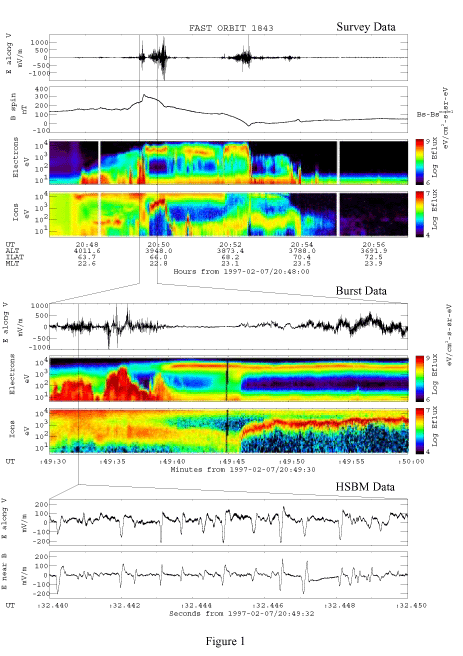 | |||
           |
Example of FAST Data Collection Rates: Survey, Burst, and HSBM
This figure shows FAST data captured during a night side auroral crossing. Data in the top four panels show the electric fields, magnetic fields minus the Earth's dipole field, electron fluxes and ion fluxes. The auroral oval is marked by the presence of energtic electrons (panel 3) and ions (panel 4) prior to 20:54 UT. Negative (positive) slopes in the perturbation magnetic field (panel 2) indicated the presence of upward (downward) field aligned currents carried primarily by down-going (up-going) electrons. Large electric fields (panel 1) are observed at the transitions in the electron flux and are part of the electric potential structure that accelerates the particles along the magnetic field. Data in the top four panels were collected at survey data rates which is several times faster than previous high altitude satellite observations. The middle three panels show burst data whose collection was triggered by an onboard algorithm sensitive to large electric fields. These data collection rates are ~100 times faster than previous observations. These high time resolution measurements revealed structure in the particle fluxes never before seen. In particular, the electrons prior to :49:40 in panel 6 are extremely intense, field-aligned, up-going fluxes that can change dramatically on ~100 millisecond time scales. The bottom panels shows high speed burst memory waveform capture of fast electron solitary waves that are common within the up-going electron fluxes. The dipolar signature in panel 8 combined with the unipolar signature in panel 7, revealed that these structures are spherical bubbles of positive charge that travel up the magnetic field at speeds of several thousand kilometers per second. This figure demonstrates the range of data capture available on the FAST satellite which was designed to optimize scientifically interesting observations. Webpage maintained by Webster. | ||